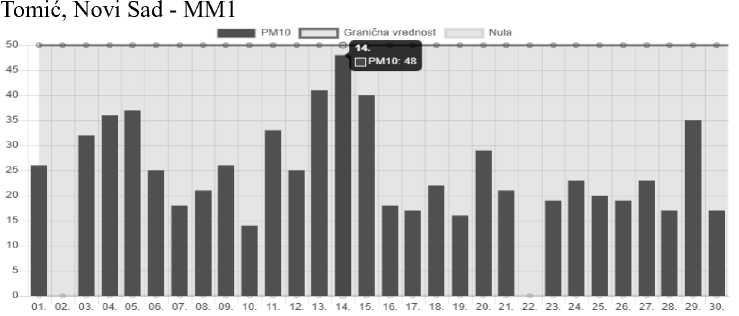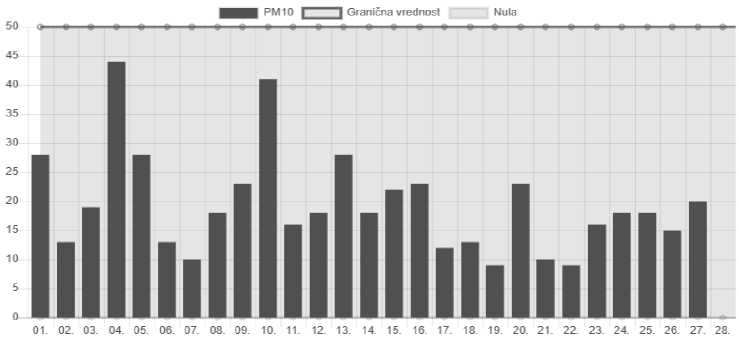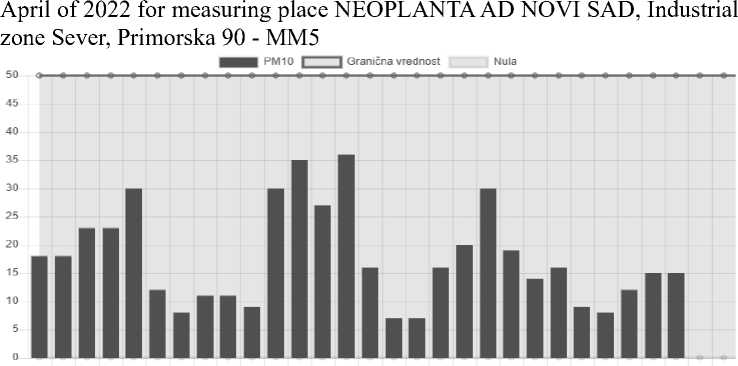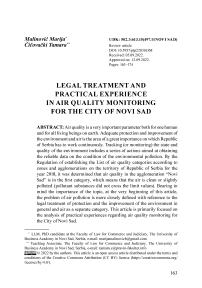Legal treatment and practical experience in air quality monitoring for the City of Novi Sad
Автор: Marija Malinović, Tamara Čičovački
Журнал: Pravo - teorija i praksa @pravni-fakultet
Рубрика: Review paper
Статья в выпуске: 3 vol.39, 2022 года.
Бесплатный доступ
Air quality is a very important parameter both for one human and for all living beings on earth. Adequate protection and improvement of the environment and air is the area of a great importance on which Republic of Serbia has to work continuously. Tracking (or monitoring) the state and quality of the environment includes a series of actions aimed at obtaining the reliable data on the condition of the environmental pollution. By the Regulation of establishing the List of air quality categories according to zones and agglomerations on the territory of Republic of Serbia for the year 2018, it was determined that air quality in the agglomeration “Novi Sad” is in the first category, which means that the air is clean or slightly polluted (pollutant substances did not cross the limit values). Bearing in mind the importance of the topic, at the very beginning of this article, the problem of air pollution is more closely defined with reference to the legal treatment of protection and the improvement of the environment in general and air as a separate category. This article is primarily focused on the analysis of practical experiences regarding air quality monitoring for the City of Novi Sad.
Air quality, Air Protection Act, Environment Protection Act, monitoring, Novi Sad
Короткий адрес: https://sciup.org/170202180
IDR: 170202180 | УДК: 502.3:613.15(497.11NOVI SAD) | DOI: 10.5937/ptp2203163M
Текст научной статьи Legal treatment and practical experience in air quality monitoring for the City of Novi Sad
Tracking of the condition and quality of the environment (that is, monitoring) is carried out with the primary goal of obtaining reliable information about environmental parameters at a specific location.
The environment in its essence is one of the pillars of sustainable development, and a healthy environment is one of the basic human rights.
According to the Article 3 of the Environmental Protection law (2004) of the Republic of Serbia: “Environmental quality is the state of the environment that is manifested by physical, chemical,biological, aesthetic and other indicators, environmental pollution is puttingthe polluting substances or energy into the environment, caused by human activity or natural processes that have or may have harmful consequences on the quality of the environment and human health, while environmental degradation is the process of impairing the quality of the environment which is caused by natural activity or human activity or is a consequence of taking non of the measures for eliminatingthe causes of quality deterioration or damage to the environment, natural or by work created values”.
Tracking (or monitoring) the condition and quality of the environment “includes a series of actions aimed to obtain reliable data on the state and pollution of the environment. These actions are measuring the presence of pollutants, processing the results and reporting” (Monitoring the state and quality of the environment, 2022).
Monitoring is carried out by “systematic measurement, examination and evaluation of indicatorsof environmental state and pollution, which includes the monitoring of natural factors, changes instate and characteristics of the environment, including cross-border monitoring, namely: air, water, soil, forests, biodiversity, flora and fauna, climate elements, ozone layer, ionizing and non-ionizing radiation, noise, waste, early warning of accidents with monitoring and assessment of the development of environmental pollution, as well as international contract obligations” (Monitoring the state and quality of the environment, 2022).
In this article, at the very beginning, the problem of air pollution is more closely defined with reference to the legal treatment of protection and improvement of the environment in general and air as a separate categories. The primary attention in this paper will be focused on the analysis of practical experiences of air quality monitoring for the City of Novi Sad.
-
2. Air pollution and legal treatment of protecting and improving the environment and air
Adequate protection and improvement of the environment is a field that the Republic of Serbia should work on continuously. This is especially important when considering that pollution and environmental degradation in our country is a problem that has been very conspicious in recent decades. How Besermenyi (2007) states in his work, “the problem of air pollution is particularly present, which is primarily a consequence of an extremely low level of environmental awareness, as well as a lack of professional education, in the field of environment” (p. 495).
Polluted air has a negative impact on many spheres of human life and work. Yet, health isues are something that definitely needs to be in the first place when we talk about harmful influence of the contaminated air we breathe. Kukolj (2020) states that “according to the data of the World Health Organization, polluted air kills seven million people every year globally, while it is estimated that only in Europe, about 550,000 people die annually, of which approximately 6,600 deaths in the Republic of Serbia” (p. 7).
According to Jovančević and associates (2020), “for air quality monitoring in the state, the Environmental Protection Agency is in charge, which represents the republic organization responsible for hydrological and meteorological affairs and authorized legal entities. Regarding the local network of measuring stations, according to the Air Protection Act, this network consists of additional measuring stationsand/or measuring places that the competent authority of the autonomous province and the competent authoritythe local self-government unit determines based on measurements or evaluation procedures for zones
I agglomerations for which there is no data on the level of pollutants, in accordance with the needs and possibilities” (p. 15).
Article 7 of the Regulation of Monitoring Conditions and Air Quality Requirements (2010) regulates that “the level of air pollution in the territory of Serbia is monitored by measuring concentrations of sulfur dioxide, nitrogen dioxide and nitrogen oxides, suspended particles (PM10, PM2.5), lead, benzene, carbon monoxide, ground ozone, arsenic, cadmium, mercury, nickel and benzo(a)pyrene in air with automatic measuring instruments and/ or taking samples and analising”.
Assessment of air quality from Article 21 of the Regulation on conditions for monitoring and requirements of air quality (2010) contains data on: 1) the level of pollution when the value of tolerance is exceeded , zones and agglomerations where those values were measured by dates and periods of duration; 2) the level of pollution when the limit value is exceeded, zones and agglomerationswhere those values were measured and dates and periods of duration; 3) causes of exceeding tolerance and/or limit values; 4) exceeding critical levels, zones and agglomerations where those values were measured and dates and periods of duration; 5) zones and agglomerations in which the values of polluting substances are below the limit values; 6) arithmetic mean, median, 98th percentile, measurement uncertainty, minimum value, maximum value, detection limits and quantification limits; 7) the average annual value of concentrations ground ozone precursors; 8) the methods applied during air quality assessment”.
This approach is in accordance with Article 2 of the Law on Environmental Protection (2004) of the Republic of Serbia, which states that “the environmental protection system consists of measures, conditions and instruments for: 1) sustainable management, preservation of natural balance, integrity, diversity and the quality of natural values and conditions for the survival of all living beings; 2) prevention, control, reduction and remediation of all forms of environmental pollution”.
Also, Article 10 stipulates that “sustainable management and protection of natural values of the environment is established by this law, special laws and other regulations that determines: 1) assessment of the impact of plans, programs and projects on the environment; 2) integrated pollution prevention and control; 3)protection of nature; 4) protection of air, water, soil, forests, geological resources; 5) management of chemicals; 6) waste management; 7) ionizing I non-ionizing radiation; 8) protection against noise and vibrations; 8a) control of the risk of a major accident which includes hazardous substances; 8b) cross-border traffic and trade of wild species”.
In accordance with the previously presented Article 10 of the Law on Environmental Protection (2004) of the Republic of Serbia, the provisions of the Air Protection Act (2009) will be presented in more detail, as a special and very important law in this area.
According to the provisions of Article 3 of the Air Protection Act (2009), air is “air in the outdoor troposphere that does not include indoor air’.
Organized monitoring of the state and quality of the environment began in Serbia in the year 2002. The first provisions on monitoring the state and quality of the environment are included in the Law on environmental protection in 2004.
Air protection, in accordance with Article 2, is achieved by: “1) establishing, maintenaningand improving the unique air quality management system on the territory of the Republic of Serbia; 2) preserving and improving air quality through establishing and implementing measures in areas of protection in order to prevent or reduce harmful consequences for human health and/or environment ; 3) by avoiding, preventing and reducing pollution that affects and damages ozone layer; 4) by monitoring, obtaining and evaluating important data on air quality based on measurements and standardized methods; 5) providing availability of air quality data; 6) by performing obligations in accordance with the confirmed international agreements; 7) international cooperation in the field of protection and improvement of air quality and by ensuring the availability of that data to the public”.
According to the Article 7, “in the Republic of Serbia, air quality is evaluated based on the level of polluting substances depending on the lower and upper limits of assessment, namely: 1) in all zones and agglomerations in which the level of polluting substances exceeds the upper assessment limit for those polluting substances, data obtained by fixed measurements that can be supplemented with data obtained by modeling techniques and/or indicative measurements; 2) in all zones and agglomerations where the level of pollutants is below the estimated upper limit established for those polluting substances, for estimatingair quality we can use combination of fixed measurements and modeling techniques and/or indicative measurements; 3) in all zones and agglomerations where the level of polluting substances is below the estimated lower limit established for those polluting substances,modeling and/or assessment techniques can be used to assess air quality”.
According to the Article 9, “in order to effectively manage air quality, a unique functional system is established for monitoring and controlling the level of air pollution and maintenaningdatabases on air quality (air quality monitoring). Republic of Serbia, autonomous province and unit of local self-government, within the scope of its competence established by law, are providing monitoring of air quality”.
According to the level of pollution, starting from the prescribed limit and tolerance values, andbased on the measurement results, the following categories of air quality are determined: “1) first category - clean or slightly polluted air where the limited values are not exceeded for any pollutant; 2) second category - moderately polluted air where the limit values are exceeded for one or more pollutants, but tolerance values of any pollutant are not exceded; 3) third category - excessively polluted air where the tolerance values are exceeded by one or more polluting substances” (Article 21).
The Air Protection Act (2009) is also establishing that “in the zone and/or agglomeration where it was determined that the air quality is of the first category, preventive measures were implemented toprevent air pollution to exceed limit values. Also, in the zone and/or agglomeration in which it is determined that the air quality is in the second category, measures are implemented to reduce air pollution, in order to reach the limit values, as well as to reduce them to be below the limit values. Finally, in the zone and/or agglomeration where the air quality has been determined to be in the third categorie, measures are implemented to reduce air pollution, for the sake of achieving short-term tolerance values and securing long-term limit values” (Article 22).
Finally, according to the Article 40, “measures of prevention and reduction of air pollution and improvement of air quality includes: 1) prescribing limit values of emissions of polluting substances from stationary pollution sources; 2) prescribing limit values of emission of pollutants from mobile sources of pollution; 3) alignment with the maximum national emissions established for certain pollutants; 4) determing the allowed amounts of certain polluting substances in certain products; 5) reduction of greenhouse gas emissions; 6) gradual reducing the substances that damage the ozone layer; 7) other measures for pollution prevention and reduction”.
-
3. Practical experiences regarding air quality monitoring for the City of Novi Sad
According to the Environmental Protection Program of the City of Novi Sad for the period from year 2015 to year 2024 (2015), “in order to effectively manage air quality, in the territory of the City of Novi Sad, a unique functional system of monitoring and controlling the degree of air pollution has been established (air quality monitoring). Air quality monitoring on the territory of the City of Novi Sad is enabled by the state, provincial and local network.
The state network consists of two automatic air quality measurement stations, namely Novi Sad-Liman and Novi Sad-Spens, and autonomous provincehasone station for automatic air quality measurement, Novi Sad–Shanghai. A local network of measuring points for measuring the level of pollutants in the air has been established by the Air Quality Control Program for the territory of the City of Novi Sad, in accordance with Regulation on conditions for monitoring and air quality requirements, with the consent of the competent ministry”.
According to the official data of the City Administration for Environmental Protection, “air quality, as one of the basic parameters of the condition of the environment, is monitored on the territory of the Cityof Novi Sad since 1971” (Air quality monitoring of the City of Novi Sad, 2022).
The air quality control program for the territory of the City of Novi Sad “establishes a local network of measuring points for measuring the level of pollutants in the air, that is, assessing the air quality, the number and arrangement of measuring points, as well as the extent, type and measurement frequency” (Air quality monitoring of the City of Novi Sad, 2022). The following table presents the local network of measuring points for measuring the levels of pollutants in the air in the territory of the City of Novi Sad.
Table 1. local network of measuring points for measuring the level of pollutants in the air for the territory of the City of Novi Sad
|
Merno mesto (MM) |
Skraćeni naziv |
|
|
1 |
Ugao Rumenačke ulice i Bulevara Jaše Tomića, Novi Sad |
MM1 |
|
2 |
Mesna zajednica Kać, Kralja Petra I broj 2, Kać |
MM2 |
|
3 |
JKP ”Vodovod i kanalizacija”, PPDV Sunčani kej 41, Novi Sad |
MM3 |
|
4 |
SOS DEČJE SELO ”Dr Milorad Pavlović”, Kamenički park 1-14, Sremska Kamenica |
MM4 |
|
5 |
NEOPLANTA AD NOVI SAD, Industrijska zona Sever, Primorska 90 |
MM5 |
Source: Air quality monitoring for the city of Novi Sad
As part of this analysis, we will review the practical experiences regarding air quality monitoring for the City of Novi Sad, which is based on concentration of PM10 (suspended particles) (µg/m³/hour) in the air, amounts of soot and metals), and keeping in mind the last available reports, for the measuring unit placed on the Corner of Rumenačka Street and BoulevardJašaTomić, Novi Sad - MM1, JKP (ili public communal company) “Water supply and sewerage”, PPDV Sunčanikej 41, Novi Sad - MM3 and NEOPLANTA AD NOVI SAD, Industrial zone Sever, Primorska 90 - MM5
Graph 1. Concentration of PM10 (µg/m³/hour) in the air during the month of April 2022 for measuring place Corner of Rumenačka Street and Bulevar Jaša

Source: City Administration for Environmental Protection. Measuring point Corner of Rumenačka Street and JašaTomić Boulevard, Novi Sad - MM1 [Measuring point Corner of Rumenacka Street and JašaTomić Boulevard, Novi Sad - MM1].Downloaded 2022, June 15 from
Graph 2. Concentration of PM10 (µg/m³/hour) in the air during February 2022 for measuring point JKP “Vodovodikanalizacija”, PPDV Sunčanikej 41,
Novi Sad - MM3

Source: City Administration for Environmental Protection. Measuring point of jkp “Water and sewerage”, PPDV Sunčanikej41, Novi Sad – MM3 [Measuring point JKP "Water and sewerage", PPDV Sunčani quay 41, Novi Sad – MM3]. Downloaded 2022, June 15 from
Graph 3. Concentration of PM10 (µg/m³/hour) in the air during the month of

01. 02. 03. 04. 05. 06. 07. 03. 09. 10. 11. 12. 13. 14. 15. 16. 17. 18. 19. 20. 21. 22. 23. 24. 25. 26. 27. 23. 29. 30.
Source: City Administration for Environmental Protection. Measuring point NEOPLANTA AD NOVI SAD, Industrijskazona Sever, Primorska 90 – MM5 [Measuring point NEOPLANTA AD NOVI SAD, Industrial zone North, Primorska 90 – MM5]. Downloaded 2022, June 15 from
Comparing the data for the observed period (February 2022 - April 2022) for the indicator - the concentration of PM10 (µg/m³/hour) in the air, the amount of soot and metals), it can be observed that the amount of PM10 is the most represented within the measuring unit Corner of Rumenačka Street and Boulevard JašaTomić, Novi Sad - MM1. However, all the parameters on the graphs are individually recording variable values on a daily basis, and it is not possible to determine any of the three observed measuring points asthe dominant one, according to the level of polluted air.
-
4. Conclusion
One of the general goals of the environmental protection policy of the City of Novi Sad is precisely this improvement of the monitoring system and reporting about the state of the environment. According to the guidelinesOf Environmental Protection Program, although the City of Novi Sad has a developed monitoring system of the environmental elements, in order to improve it is necessary, among other things, to achieve the goal - improved air quality control indicators.
In terms of this goal, it was emphasized thatvithin the current legal regulation, which stipulates air protection, and as part of international obligations, air quality should be monitored in populated places, industrial and uninhabited areas, air quality in protected natural goodsand the areas that contain protected immovable cultural assets, air quality in areas under the influence of certain sources of pollution, including mobile sources and allergenic pollen.
By the Regulation of establishing the List of air quality categories by zone and agglomerations on the territory of the Republic of Serbia for the year 2018 (2020), it was determined that “air quality in the agglomeration “Novi Sad” is in category I, which means that the air is clean or slightly polluted (pollutant substances did not cross the limit values). The situation was the same in previous years.”
Bearing in mind the importance of the topic, in this article, at the very beginning, the problem of air pollution is more closely defined with reference to the legal treatment of protection and improvement of the environment in general and air as a separate category. The primary focus in this paper was the analysis of practical experiences of air quality monitoring for the City of Novi Sad, after which we stated all of the previous conclusions.
Malinović Marija
Pravni fakultet za privredu i pravosuđe u Novom Sadu, Univerzitet Privredna akademija u Novom Sadu, Srbija
Čičovački Tamara
Pravni fakultet za privredu i pravosuđe u Novom Sadu, Univerzitet Privredna akademija u Novom Sadu, Srbija
ZAKONSKI TRETMAN I ISKUSTVA U PRAKSI POVODOM MONITORINGA KVALITETA VAZDUHA
ZA GRAD NOVI SAD
REZIME: Kvalitet vazduha je vrlo važan parametar kako za čoveka tako i za čitav živi svet na zemlji. Adekvatna zaštita i unapređenje životne sredine i vazduha jeste oblast na kojoj u Republici Srbiji treba kontinuirano raditi.
Praćenje (ili monitoring) stanja i kvaliteta životne sredine obuhvata niz radnji koje kao cilj imaju dobijanje pouzdanih podataka o stanju i zagađenju životne sredine. Uredbom o utvrđivanju Liste kategorija kvaliteta vazduha po zonama i aglomeracijama na teritoriji Republike Srbije za 2018. godinu utvrđeno je da je kvalitet vazduha u aglomeraciji „Novi Sad“ I kategorije, što znači da je vazduh čist ili neznatno zagađen (nisu prekoračene granične vrednosti nivoa ni za jednu zagađujuću materiju). Imajući u vidu značaj teme, u radu je, na samom početku, bliže opredeljen problem zagađenja vazduha uz osvrt na zakonski tretman zaštite i unapređenja životne sredine uopšte i vazduha kao zasebne kategorije. Primarna pažnja u radu usmerena je na analizu iskustava u praksi povodom monitoringa kvaliteta vazduha za Grad Novi Sad.
Ključne reči : kvalitet vazduha, Zakon o zaštiti vazduha, Zakon o zaštiti životne sredine, monitoring, Novi Sad.
Список литературы Legal treatment and practical experience in air quality monitoring for the City of Novi Sad
- Besermenji, S. (2007). Zagađenje vazduha u Srbiji [Air pollution in Serbia]. Journal of the Geographical Institute “Jovan Cvijić” SASA, 57, pp. 495–501
- Gradska uprava za zaštitu životne sredine. Merno mesto Ugao Rumenačke ulice i Bulevara Jaše Tomića, Novi Sad – MM1 [Measuring point Corner of Rumenacka Street and Jaša Tomić Boulevard, Novi Sad - MM1]. Downloaded 2022, June 15 from https://environovisad.rs/air_points/mm1/years/2022
- Gradska uprava za zaštitu životne sredine. Merno mesto JKP ”Vodovod i kanalizacija”, PPDV Sunčani kej 41, Novi Sad – MM3 [Measuring point JKP “Vodovod i kanalizacija”, PPDV Sunčani kej 41, Novi Sad - MM3]. Downloaded 2022, June 15 from https://environovisad.rs/air_points/mm3/years/2022
- Gradska uprava za zaštitu životne sredine. Merno mesto NEOPLANTA AD NOVI SAD, Industrijska zona Sever, Primorska 90 – MM5 [Measuring point NEOPLANTA AD NOVI SAD, Industrial zone North, Primorska 90 - MM5]. Downloaded 2022, June 15 from https://environovisad.rs/air_points/mm5/years/2022
- Jovančević, I., Avramović, T., & Pantić, O. (2020). Kvalitet vazduha u Republici Srbiji: od merenja ka merama [Air quality in the Republic of Serbia: from measurement to measurement]. Beograd: Beogradska otvorena škola
- Kukolj, S. (2020). Zagađenje vazduha i Covid-19 [Air pollution and Covid-19]. Beograd: Beogradska otvorena škola
- Matijašević-Obradović, J., & Zarubica, S. (2020). Participation of the Activity Classification Sectors in the Emission of Pollutants, with regard to Criminal Legislation. Economics of Agriculture, 67 (1), pp. 239–252
- Monitoring kvaliteta vazduha Grada Novog Sada [Monitoring the air quality of the City of Novi Sad]. Downloaded 2022, June 12 from https://environovisad.rs/vazduh
- Počuča, M., & Matijašević-Obradović, J. (2020). Međusobna uslovljenost životne sredine i turizma – značaj monitoringa kvaliteta vazduha Grada Novog Sada u razvoju i unapređenju turizma [Mutual conditionality of the environment and tourism: The importance of monitoring the air quality of the City of Novi Sad in the development and improvement of tourism]. Pravo – teorija i praksa, 37 (2), pp. 17–34
- Praćenje stanja i kvaliteta životne sredine [Monitoring the state and quality of the environment]. Downloaded 2022, June 10 from https://staniste.org.rs/wp-content/uploads/2016/07/05-Monitoring-PD-srb.pdf
- Program zaštite životne sredine Grada Novog Sada za period 2015-2024 [Environmental protection program of the City of Novi Sad for the period 2015-2024]. Downloaded 2022, June 10 from http://www.novisadinvest.rs/sites/default/files/dokumenti/Program%20zastite%20zivotne%20sredine%20GNS%202015-2024.pdf
- Uredba o uslovima za monitoring i zahtevima kvaliteta vazduha [Decree on conditions for monitoring and air quality requirements]. Službeni glasnik RS, br. 11/10, 75/10 i 63/13
- Uredba o utvrđivanju Liste kategorija kvaliteta vazduha po zonama i aglomeracijama na teritoriji Republike Srbije za 2018. godinu [Decree on determining the List of air quality categories by zones and agglomerations on the territory of the Republic of Serbia for 2018]. Službeni glasnik RS, br. 88/20
- Zakon o zaštiti životne sredine [Law on Environmental Protection]. Službeni glasnik RS, br. 135/04, 36/09, 36/09 - dr. zakon, 72/09 - dr. zakon, 43/11 - odluka US, 14/16, 76/18, 95/18 - dr. zakon i 95/18 - dr. zakon
- Zakon o zaštiti vazduha [Air Protection Act]. Službeni glasnik RS, br. 36/09, 10/13 i 26/21 - dr. zakon


